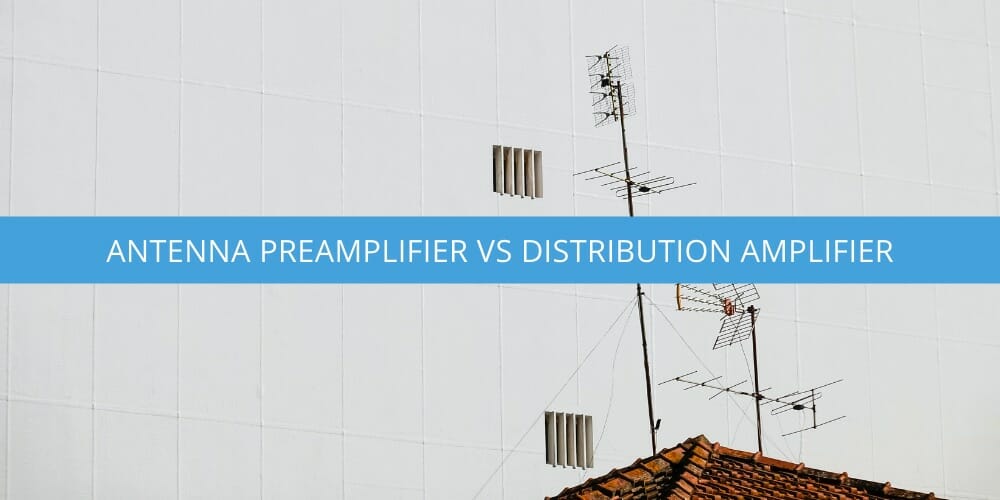An antenna Preamplifier and Distribution Amplifier work differently. An antenna preamplifier is a device that amplifies the TV signal as it flows from the antenna. On the other hand, a Distribution Amplifier is used with a splitter to divide and amplify a single visual or audio source into two similar copies.
Those mentioned differences above between both tools are just some of them. If you are wondering which is what, this is the right place for you! In this article, let’s discuss all you need to know about antenna preamplifiers vs. distribution amplifiers.
Antenna Preamplifier
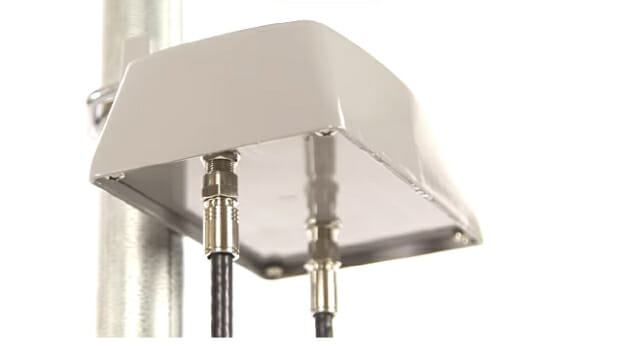
Any antenna amplifier is intended to compensate for signal attenuation, not acquire new stations that are not hitting your antenna. An antenna preamplifier is one in which the amplifier is installed before the signal interruption. The signal is amplified at its strongest point due to the preamplifier’s placement to compensate for signal loss caused by the long cable length between the antenna and your splitter or TV.
In most cases, a power inserter connects the preamplifier with your TV set to send power to the preamplifier, ensuring you don’t encounter signal loss in the long run. The preamplifier is usually attached to the antenna’s mast, allowing it to acquire and amplify the incoming signal from the antenna directly.
Here’s your guide on the best TV antenna amplifier.
Antenna Preamplifier: Common Issues To Look For
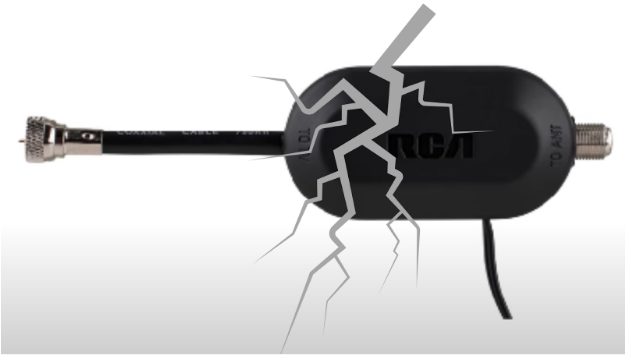
- If you get signals from weaker stations but no reception on a closer channel, it could be due to an overdriven signal created by amplifying already too-high signals.
- If you try to use the antenna to acquire FM frequency but cannot, it could be due to a built-in function called FM Trap. Because the frequency of FM can often interact with TV reception, some antennas possess a mechanism that allows them to filter out FM signals. You can turn off the FM Trap feature if you still wish to get FM.
- Installation of devices between the antenna amplifier and the power source could cause the preamplifier not to turn on. Check if the cable wires are in good working order or damaged. Although a coax cable can be broken and still transmit a TV signal, it will not carry electricity.
Distribution Amplifier
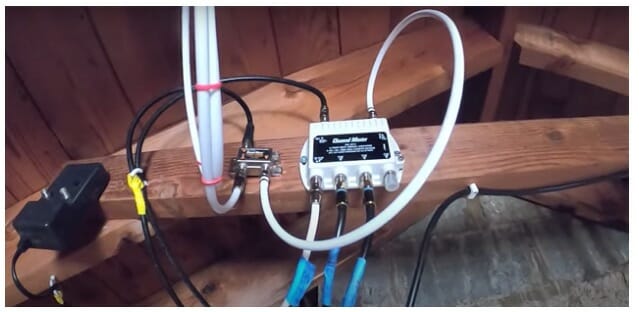
A distribution amplifier, also known as the DA, is a tool with a splitter that takes a single input signal and sends it to several separate outputs simultaneously. These devices allow signals to be transmitted to various destinations without signal degradation. Both digital and analog signals can be amplified using a distribution amplifier:
- Analog Signals: As an input, analog distribution amplifiers amplify the antenna signal to a higher frequency and disperse it among several outputs. By amplification, the analog distribution amps improve the waveform by enhancing features such as amplitude peaking, fixed or variable signal strength, etc.
- Digital Signals: The digital media signals are amplified and distributed using digital distribution amplifiers. The digital distribution amps provide signal rectification to avoid signal buffering. Re-clocking maintains the integrity of the data channel and the transmission rate performance and bit errors.
The primary idea of an antenna distribution amplifier is that when a signal is split or dispersed by a splitter or other means, it will have a signal loss. In addition, if a TV is connected to a long cable, causing it to be further from the splitter, the more signal loss there will be. A distribution amplifier is placed to fix this type of problem. This is why it’s necessary to position the DA relative to the TV’s location.
In an analog system, signal attenuation can corrupt or degrade the original signal’s higher frequency, affecting the picture’s clarity and sharpness.
Meanwhile, when a digital signal is divided, the signal level can drop below typical operating levels, resulting in data transmission failure. This is the “digital cliff,” so a distribution amplifier is required even in a digital system.
Amplifiers: Does It Work?
Yes, TV amplifiers are effective. They can aid in the reduction of signal loss caused by cable resistance and the splitting of signals across multiple TVs. However, they won’t magically transform a bad or weak TV signal into a good, dependable one. They can resolve your signal troubles if appropriately used.
When To Install an Antenna Preamplifier?
There are a couple of considerations before installing an antenna preamplifier. Note that preamplifiers can only amplify signals already accessible in your area, so it won’t guarantee that you will possibly get additional TV channels if your signal is already weak.
However, suppose you are confused about the best time to install an antenna preamplifier. In that case, you should remember that a preamplifier may only be beneficial to your TV setup if:
- You live in a neighborhood where the signal is weaker, yet the picture isn’t as sharp or clear as it may be.
- There are cases where the cable is 50 feet or longer from the antenna to the TV/splitter or from the splitter to the TV.
- You use a signal splitter, and then a preamplifier can assist you in overcoming signal setbacks in most circumstances.
Remember that if your TV signal is already sufficient and you are closer than 20 miles away from the transmitter, you may want to consider a different solution because when amplified, very strong signals can be distorted, creating a variety of reception troubles.
When To Install a Distribution Amplifier?
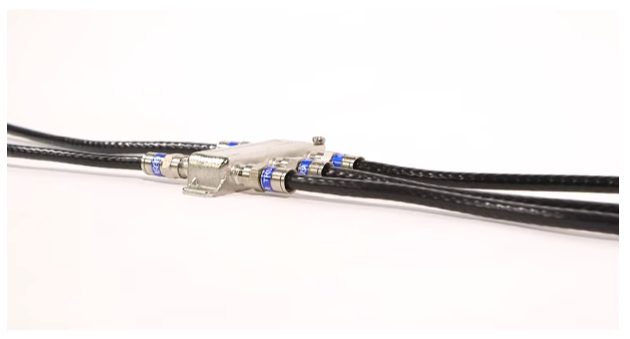
It is essential to know that you only need an antenna distribution amplifier installed if you use a splitter. In addition, you will need a distribution amplifier only if you have over one TV in your home. The original signal will be disrupted by using a splitter.
| 4 dB signal loss | 2-way splitter |
| 8 dB signal loss | Three or 4-way splitter |
| 14-16 dB signal loss | 8-way splitter |
Consider the following factors when deciding between different distribution amplifiers:
- The signal type that will be distributed.
- The number of TVs that you would require.
- The distance between the splitter and your TVs.
- The location of its installation.
Warning: Even after the main power supply is disconnected, the installation of video DA units raises the risk of electrocution due to possible residual electric current in the network. It is critical to acquire these services from professionals and carry out the installation precisely and safely to avoid certain dangers. (1)
Step-by-Step Distribution Amplifier Installation Method
Step 1: Before inserting it into an electrical socket, ensure all the TV or splitter’s inputs are connected.
Step 2: Find a suitable area for installing the distribution amplifier. The basic rule of thumb is to pick a location as central as possible between your several TVs to lessen the signal loss.
Step 3: Place the distribution amplifier where it won’t be disturbed.
Step 4: Connect the power supply to an input marked as “Power In” or similar with a cable.
Step 5: Connect the “input,” “RF in,” or similar label on the coax cable that comes out of the antenna to the distribution amplifier’s “input.”
Step 6: Connect every distribution amplifier’s outputs with wires to individual TVs.
Step 7: If the distribution amplifier allows, you can utilize termination caps to turn off unused outputs.
Step 8: Finally, plug the power supply into a wall socket, and you’re ready.
And if you want a DIY project, you may check this learning guide on making a TV antenna amplifier.
FAQs
Can a Preamplifier and a Distribution Amplifier be Installed Together?
You can use the antenna system to install both a distribution amp and an antenna preamplifier. There are, however, two significant concerns:
1. You must ensure that both of them have access to electricity. Installing the distribution amplifier between the preamplifier and the power supply of the preamplifier can trigger a voltage block. (2)
2. Be aware that there is a thing called signal overdrive. You don’t have to amplify the received signal if it’s already strong after using the splitter.
I have given my insights about what Antenna Preamplifier vs. Distribution Amplifier is. If you want to try using both the preamplifier and the distribution amp, you can do many other setups.
References
(1) electric current – https://www.britannica.com/science/electric-current
(2) voltage – https://whatis.techtarget.com/definition/voltage

